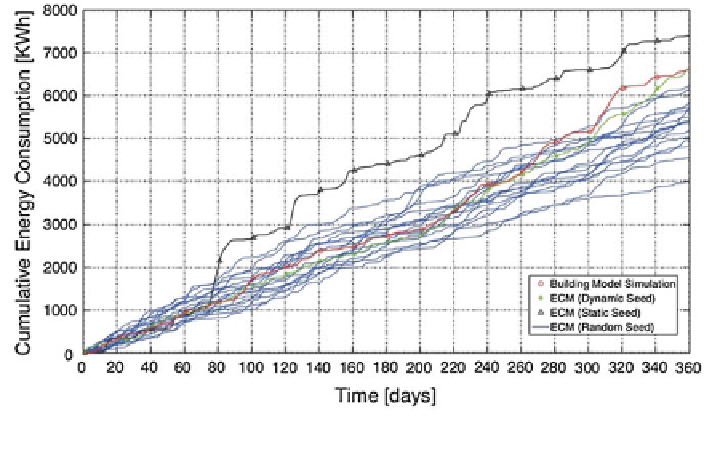Civil Engineering Reference
In-Depth Information
Fig. 12 Building A ECM simulations with random seeds and comparison with the building
energy consumption
The stochastic nature of the ECM is illustrated in Fig.
12
. This figure represents
the ECM simulations obtained in building A. In the absence of a systematic
method of generating a sequence and, at the same time guaranteeing a lower
prediction error, the sequences are randomly generated. Each time the ECM is
simulated a new, and often different, sequence is produced. This sequence is the
combination of each Markov chain predicted sequence. As illustrated in Fig.
12
,
some predictions poorly represent the building, for example, the prediction using
the static algorithm (line with triangles) is completely degraded.
In order to analyse and validate the effect of different occupant behavioural
models on the building energy consumption, Figs.
13
,
14
and
15
illustrate the
results for simulations performed in building A. Figure
13
represents an energy
efficient scenario, in which no energy savings are predicted. This is the outcome of
a conservative behaviour, where the occupants are simulated to be concerned with
the energy consumption within the building. In contrast, we have an energy
inefficient scenario represented in Fig.
14
. In this case, the occupants are simulated
to have a wasteful behaviour, with no respect for the energy use in the building. In
the between, we have a more common scenario (Fig.
15
). This scenario is char-
acterised by a combination of the previously described behaviours. By comparing
these figures, the dynamic algorithm provides better predictions than with the
static algorithm. Moreover, although the daily energy consumption predictions
differ from the building, the ECM reliable predicts the building's total energy
consumption.
A residual analysis between the previous simulations is illustrated in Fig.
16
.
The simulations 1-17 are performed applying a random seed. The simulations 18

